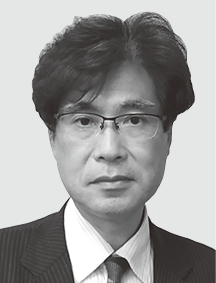OverviewHitachi Solutions for Environmental Challenges Facing Industrial Sector
Highlight
Acknowledging the global growth of environmental awareness, an increasing number of industrial companies are prioritizing carbon neutrality and resource recycling, creating widespread demand for solutions to environmental challenges. As part of this movement, Hitachi is responding to the needs of its corporate customers with digital solutions that make the systems that support society more efficient and help to build resilient supply chains. This section describes Hitachi’s recent activities in the industrial sector, including solutions for decarbonization and cyber-physical systems for overcoming environmental challenges.

Introduction
With its mission of “Contributing to society through the development of superior, original technology and products,” Hitachi supplies a variety of technologies and solutions for industry as it plays its part in addressing the environmental problems that are among the critical challenges facing society.
For example, Hitachi’s digital solutions equipped with the latest technology are helping reduce carbon dioxide (CO2) emissions by improving the efficiency of the systems that support society. Hitachi is also helping to decarbonize industry by putting these digital solutions to use in building resilient supply chains.
Meanwhile, Hitachi is addressing such global problems as the increasing rate of resource extraction, use, and disposal. This involves working with customers and wider society to create a water- and resource-recycling society, including through the creation of value chains that achieve circularity in resource use.
This article describes digital solutions for industry that help to reduce the load on the environment as well as Hitachi’s technologies and the role it is playing in the creation of a circular economy.
Hitachi Digital Solutions for Industry that Help Reduce the Environmental Load
The operating environment and values of companies in the industrial sector are changing significantly against a backdrop of increasing uncertainty in people’s lives, including a rising awareness globally of the environment, societal changes resulting from COVID-19, and heightened geopolitical risk. To help companies overcome these complex and wide-ranging management challenges, the Industrial Digital Business Unit at Hitachi operates on the basis of improving customer value through the supply of total seamless solutions that draw on its combined strengths in IT, operational technology (OT), and products. It contributes to social innovation by serving as a full-service provider of robotics system integration (SI) and digital solutions that integrate IT and OT.
Taking a broad view of industry and how it can reduce the load on the environment, what is important is to work toward carbon neutrality across the entire supply chain from start to finish rather than leaving it to the individual companies involved to reduce their own CO2 emissions.
By utilizing a variety of solutions powered by digital technology to improve the efficiency of customer business processes, Hitachi’s Industrial Digital Business Unit is helping to reduce the load that industry imposes on the environment by shortening both the time and distance for those business processes that are environmentally damaging.
One example of how Hitachi helps reduce the load on the environment in manufacturing is through the supply of solutions that support the scheduling and execution of production and sales in response to fluctuating demand. These solutions make production, distribution, and other operations more efficient, and optimize inventory.
In product distribution, the environment also benefits from reduced food losses and the avoidance of overstocking through automatic ordering that uses artificial intelligence (AI) to predict demand. This optimizes inventory and ensures that ordering matches requirements.
In the healthcare and pharmaceutical sectors, Hitachi is helping the environment through rigorous quality management (traceability) and by optimizing the entire value chain for products associated with regenerative medicine using a platform for the comprehensive and centralized management of cell handling and trace information.
The digital technologies used to achieve this optimization take the form of Hitachi cyber-physical systems (CPSs). The optimization of real-world operations is achieved by collecting and modeling the large quantities of information in diverse forms derived from business processes in physical space, conducting analyses and simulations in cyberspace to find optimal solutions that are then used as feedback to physical space (see Figure 1).
Past practice for optimization like this has focused on particular business processes within a company, with improvements being made across the vertical axis from the workplace up to management. What is called for now, in contrast, is improvements such as CO2 reduction and greater flexibility that span entire supply chains encompassing multiple companies. However, the problems to be solved are becoming more complex and challenging as the scope of optimization expands, the variety and quantity of data to be collected and analyzed grows, and the number of companies involved increases. Another factor that makes the optimization of entire supply chains difficult is the existence of discontinuities between business processes, departments, and companies, what in Japanese are called “kiwa” (gaps). Hitachi achieves system-wide optimization by using CPSs to span these gaps and solve complex and difficult problems.
While market uncertainties are growing and the issues to be resolved are becoming more complex and multifaceted, Hitachi’s Industrial Digital Business Unit intends to combine reduced environmental impact with greater economic value while also supporting business process improvement by customers. Key to achieving this is connectivity across the solutions and products used to present and analyze information from the production workplace across the entire value chain.
Figure 1 — Use of CPSs for Optimization  Hitachi is building new businesses and ecosystems by delivering reliability and flexibility in ways that can be utilized by the wide range of businesses that make up the supply chain, and also through its real-time capabilities for the analysis in cyberspace of large quantities of operational data collected in diverse forms and its use to obtain optimal solutions for feedback to operations.
Hitachi is building new businesses and ecosystems by delivering reliability and flexibility in ways that can be utilized by the wide range of businesses that make up the supply chain, and also through its real-time capabilities for the analysis in cyberspace of large quantities of operational data collected in diverse forms and its use to obtain optimal solutions for feedback to operations.
Hitachi Technologies for Industry and its Role in Achieving a Circular Economy
Figure 2 — Circular Economy  The diagram shows other ways in which resource circularity can be achieved in addition to conventional recycling routes.
The diagram shows other ways in which resource circularity can be achieved in addition to conventional recycling routes.
The circumstances surrounding resources have changed significantly in recent years. The difficulty of procuring necessary resources has emerged as a critical issue for many industries. The factors behind this include the rise in resource consumption due to global economic development and population growth, along with commodity price inflation driven by heightened geopolitical risk.
Likewise with used products, resource recovery has become a global issue. One example is the pollution of the ocean by discarded plastic waste and its impact on marine life.
The establishment of supply chains that extend from acquiring raw materials to the production of end products is one of the increasingly critical tasks shared by a variety of different industries and the logistics sector, as is the creation of a resource-recycling society that provides for products to be turned back into usable resources after use.
To help with this task of creating a resource-recycling society, Hitachi is working to make greater use of recycled materials in “resource arteries” (for the manufacture and sale of products) as well as achieving longer product life and reduced resource use. Likewise with “resource veins” (for the recovery and recycling of materials), Hitachi is promoting practices such as product reuse and remanufacturing.
For the recycling of home appliances, Hitachi developed a means of recovering chlorofluorocarbon gas from refrigerator insulation and patented the basic process. It also established home appliance recycling businesses in Japan’s Tochigi Prefecture and in Hokkaido and Tokyo in 1999.
These businesses obtain useful materials from automated teller machines (ATMs) and other IT equipment as well as from home appliances, recovering the rare earth metals contained in air conditioners and also recycling medical devices and smartphones.
Figure 2 shows a diagram of how a circular economy works. This encompasses not only conventional recycling (turning waste into useful materials), but also other ways in which the circularity of resource use can be achieved, such as remanufacturing, rebuilding, repairing, and extending the life of products. Hitachi is engaged in ongoing work on the recycling of industrial products, including home appliances, which is inspired by the circular economy.
Conclusions
The challenges facing the world are becoming increasingly severe and complicated amid rising market uncertainties driven by factors such as climate change, COVID-19, and geopolitical risk.
Hitachi has been working on utilizing its latest digital solutions to help create a circular economy and reduce the impact that customers have on the environment. The company has also taken up the challenge of combining human wellbeing with the creation of sustainable societies by making full use of data and technology, working to resolve societal problems through its Social Innovation Business that leverages IT, OT, and products.





